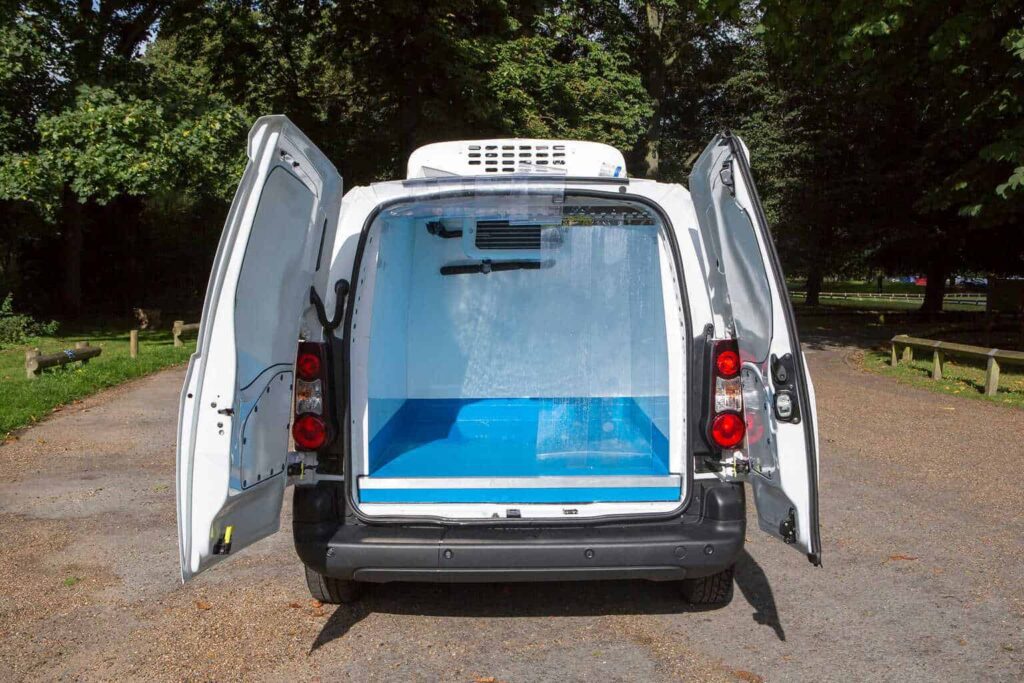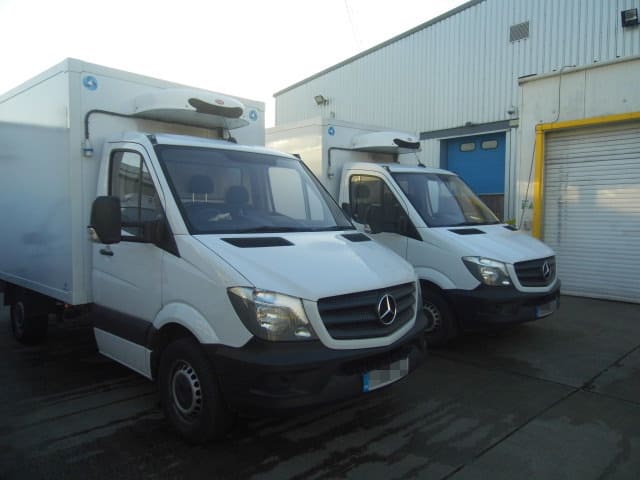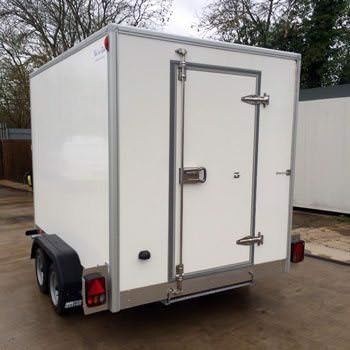Successful Management of Refrigerated Vans When It Gets Hot
Managing refrigerated vans during extreme heat is crucial for businesses reliant on temperature-sensitive goods. As temperatures soar, maintaining the integrity of your refrigerated transport can mean the difference between success and costly losses. This guide provides practical insights and strategies, with real-world examples, to ensure your refrigerated vans operate efficiently even in the hottest conditions.
Climate change has increased average global temperatures, resulting in more frequent and intense heat waves. This trend presents significant challenges for businesses relying on refrigerated transportation. There are countless case studies where an increase in refrigeration-related issues during the summer months over the past five years has challenged the success of a business. These challenges highlight the importance of implementing effective heat management strategies.
Perishable goods like food, pharmaceuticals, and flowers require strict temperature control to maintain quality and safety. A minor temperature deviation can result in spoiled goods, financial losses, and company reputation damage. For instance, a seafood distributor might face severe backlash after a refrigeration failure, which leads to the spoilage of an entire shipment, resulting in a significant financial hit and a loss of customer trust.
Guiding you through the issues
This guide is divided into several sections, each focusing on a critical aspect of managing refrigerated vans in extreme heat:
- Understanding the Impact of Extreme Heat
- The Importance of Temperature Control
- Inspection Checklist
- Best Practices
- Routine Maintenance
- Advanced Temperature Monitoring
- Driver Training Programs
Each section concludes with three practical tips to effectively help you implement the discussed strategies.
Understanding the Impact of Extreme Heat ON YOUR REFRIGERATED VEHICLE
Extreme heat can significantly affect refrigerated vans, leading to potential breakdowns, compromised goods, and financial losses. Recognising the risks associated with high temperatures is the first step toward effective management.
Mechanical Strain and Failures
Refrigeration units are designed to maintain a stable internal temperature despite external conditions—however, extreme heat forces these units to work harder, leading to increased wear and tear. For instance, a dairy company could experience higher maintenance costs during peak summer months due to the additional strain on their refrigeration systems.
As Operations Director, Craig Diaz, of FridgeXpress notes, “Accounting for this increased stress on your systems while financial forecasting is essential for the health of the business.”
Spoilage and Quality Degradation
High temperatures can compromise the integrity of temperature-sensitive goods. For example, a pharmaceutical company transporting vaccines might find that even slight deviations from the required temperature range could render their products ineffective. This underscores the importance of maintaining precise temperature control.
Financial and Reputational Impact
The financial impact of spoiled goods can be substantial. A florist in Nevada faced thousands of dollars in losses and damage to their reputation when a van’s cooling system failed, causing an entire shipment of flowers to wilt. Such incidents highlight the need for robust refrigeration management practices.
Practical Tips:
- Monitor Weather Forecasts: Regularly check weather forecasts and plan deliveries to avoid peak heat periods. Utilise apps that provide real-time weather updates.
- Educate Staff: Ensure your team understands the risks associated with extreme heat and the importance of temperature control. Conduct regular training sessions focused on heat management.
- Create a Heat Response Plan: Develop a comprehensive plan to address potential heat-related issues swiftly and effectively. Include protocols for rapid response in case of refrigeration failures.
The Importance of Temperature Control
Maintaining strict temperature control is vital to ensure the safety and quality of temperature-sensitive goods during transportation.
Consequences of Technical Failure on the Business
A technical failure in extreme heat can halt operations, resulting in delayed deliveries and potential loss of clients. For instance, a food delivery service would face significant financial losses and damage to its reputation when a van’s refrigeration unit failed, causing an entire shipment of frozen goods to a supermarket to be ruined. The company would have to compensate clients and face negative reviews, highlighting the importance of reliable temperature control systems.
Practical Tips:
- Regularly Check Refrigerant Levels: Ensure that refrigerant levels are adequate to handle increased workloads during hot weather. Low refrigerant levels can reduce cooling efficiency.
- Install Sunshades: Use sunshades on windows to reduce internal temperatures and the load on refrigeration units. Sunshades can significantly lower the temperature inside the van, easing the burden on the refrigeration system.
- Schedule Deliveries Wisely: Opt for early or late evening deliveries with lower temperatures. This can help reduce the risk of heat-related issues.
Inspection Checklist
Regular inspections and maintenance ensure that refrigerated vans operate efficiently in extreme heat.
Pre-Cooling the Van
Always pre-cool your van before loading. Pre-cool your van for at least 30 minutes before loading to ensure a stable internal temperature. This practice helps mitigate the impact of external heat when the van doors are opened for loading.
Pre-Cooling Tips:
- Use Automated Timers: Set automated timers to start pre-cooling the van at a specific time each day.
- Check Temperature Settings: Ensure that the pre-cooling temperature setting matches the requirements of the goods being transported.
- Monitor Pre-Cooling Progress: Use temperature sensors to monitor the pre-cooling process and confirm when the desired temperature is reached.
Loading Procedures
Load the van quickly and efficiently to minimise the time the doors are open. Use insulated blankets for added protection during loading. For instance, a florist might use thermal blankets to wrap delicate flowers, ensuring they remain cool during transit.
Efficient loading minimises temperature fluctuations inside the van. The longer the door is open, the more the temperature will rise away from the optimum.
Loading Tips:
- Organise Goods in Advance: Arrange goods near the loading area in the order they will be loaded to reduce loading time.
- Use Insulated Containers: Place sensitive items in insulated containers to provide additional temperature protection.
- Limit Door Openings: Plan loading so the van doors are opened and closed as few times as possible.
On-the-Road Practices
Plan routes to avoid peak heat hours. For instance, schedule deliveries early in the morning or late in the evening to avoid midday heat. Park in shaded areas whenever possible to reduce exposure to direct sunlight.
On-the-Road Tips:
- Route Planning Software: Utilise software to plan the most efficient and coolest routes.
- Avoid Traffic Congestion: Traffic jams can increase travel time and expose the van to higher temperatures for extended periods.
- Use Reflective Covers: Apply reflective covers to the van’s roof to reduce heat absorption.
Practical Tips:
- Keep Doors Closed: Minimise the frequency and duration of door openings during loading and unloading. Every second the door is open, cold air escapes.
- Use Thermal Curtains: Install thermal curtains inside the van to maintain a stable temperature when doors are open. These curtains act as a barrier to keep cold air in.
- Route Optimization: Use route planning software to find the shortest and coolest routes. This reduces exposure to heat and helps maintain temperature control.
Best Practices for looking after your refrigerated vehicle in the heat
Effective driving techniques can help maintain the internal temperature of refrigerated vans and ensure the safe delivery of goods.
Monitoring Systems
Utilise real-time temperature monitoring systems to keep track of internal conditions. Immediate alerts can help address issues before they escalate. For example, a pharmaceutical company might use a GPS-enabled temperature monitor that alerts the driver and central office if temperatures deviate from the norm. These systems provide real-time data and allow for quick corrective actions.
Monitoring System Tips:
- Set Up Alerts: Configure alerts for temperature deviations to notify drivers and central management immediately.
- Regular System Checks: Perform regular checks on monitoring systems to ensure they function correctly.
Emergency Protocols
Have a clear plan in case of refrigeration failure. This includes having backup units or a contingency for transferring goods to another vehicle. Keep a spare refrigerated van on standby during summer to handle emergencies. This ensures that deliveries can continue without significant delays.
Emergency Protocol Tips:
- Create an Emergency Kit: Equip vans with an emergency kit that includes spare parts, tools, and contact information for repair services.
- Develop Transfer Plans: Have a plan for quickly transferring goods to another refrigerated vehicle if necessary.
- Regular Drills: Conduct regular emergency drills to ensure drivers are familiar with the protocols and can act swiftly.
Maintenance and Upkeep
Regular maintenance of your vehicle and refrigeration unit is crucial. Scheduled checks can prevent minor issues from becoming major problems.
Maintenance Tips:
- Frequent Inspections: Increase the frequency of inspections during hot weather to catch potential issues early.
- Detailed Logs: Maintain detailed logs of maintenance activities and inspections to track performance and identify recurring problems.
- Professional Servicing: Use professional servicing for refrigeration units to ensure thorough and accurate maintenance.
Practical Tips:
- Carry Spare Parts: Stock essential spare parts in the van, such as fuses and belts, to handle minor repairs on the go. This minimises downtime in case of minor issues.
- Train Drivers on Basic Repairs: Ensure drivers know how to perform basic repairs and troubleshooting for refrigeration units. This knowledge can be invaluable in emergencies.
- Use Temperature Logs: Keep detailed logs of temperature readings to identify patterns and potential issues. Analysing these logs can help pre-emptively address problems.
Routine Maintenance
Routine maintenance is essential to ensure the reliability and efficiency of refrigerated vans, especially during extreme heat.
Refrigeration Unit Maintenance
Ensure the refrigeration unit is serviced regularly. Clean filters and check coolant levels to maintain efficiency. It would make sense to service your vans monthly in the summer and only quarterly in the colder months.
Refrigeration Unit Tips:
- Monthly Checks: Perform monthly checks on refrigeration units during summer to ensure they are in optimal condition.
- Clean Filters: Clean or replace filters regularly to maintain airflow and cooling efficiency.
- Check for Leaks: Regularly inspect the unit for refrigerant leaks and address any issues immediately.
Insulation Checks
Inspect the van’s insulation regularly for any signs of wear or damage. Good insulation helps maintain internal temperatures. A medical supply might replace their van insulation every two years to ensure optimal performance because of the value and high efficacy of the load. You might extend the period between insulation changes if your load is less volatile. Proper insulation reduces the load on the refrigeration unit.
Insulation Tips:
- Regular Inspections: Inspect insulation every six months for signs of wear and tear.
- Upgrade Insulation: Consider upgrading to high-efficiency insulation materials to improve thermal resistance.
- Seal Gaps: Ensure all gaps and seams are properly sealed to prevent cold air from escaping.
Technological Solutions
Invest in advanced technology like automated temperature controls and alert systems to enhance reliability and performance. For instance, use smart thermostats that adjust cooling levels based on external temperatures, ensuring consistent internal conditions. Advanced technology can significantly improve temperature management.
Technological Tips:
- Automated Controls: Automated temperature controls are used to maintain consistent internal temperatures.
- Real-Time Monitoring: Implement real-time monitoring systems with mobile alerts for immediate action.
- Data Analysis: Analyse temperature data to identify trends and optimise performance.
Practical Tips:
- Schedule Bi-Monthly Inspections: Increase the frequency of maintenance checks during summer months. This helps identify and address issues promptly.
- Upgrade to High-Efficiency Units: Invest in energy-efficient refrigeration units that can handle extreme temperatures better. High-efficiency units reduce energy consumption and operational costs.
- Regularly Replace Seals and Gaskets: Ensure door seals and gaskets are in good condition to prevent cold air leaks. Worn seals can compromise temperature control.
Advanced Temperature Monitoring
Advanced temperature monitoring systems can provide real-time data and alerts, helping to maintain optimal conditions and prevent losses.
Remote Monitoring Systems
Implement remote monitoring systems to keep track of temperatures from anywhere. These systems provide real-time data and alerts for immediate action. For example, a dairy delivery service uses an app that allows managers to monitor van temperatures remotely and respond quickly to any issues. Remote monitoring ensures that problems can be addressed even when the van is on the road.
Remote Monitoring Tips:
- Mobile Alerts: Ensure remote monitoring systems have mobile alert capabilities for real-time updates.
- Regular Calibration: Regularly calibrate sensors to ensure accurate temperature readings.
- Data Backup: Maintain backups of temperature data to analyse trends and improve practices.
Innovative Insulation Materials
Consider using the latest insulation materials that offer better thermal resistance. Innovations in this field can significantly improve temperature control. A logistics company adopted aerogel insulation, drastically reducing their energy consumption and improving temperature stability. Advanced insulation materials provide better protection against external temperatures.
Insulation Material Tips:
- Research Options: Stay updated on the latest insulation materials and technologies.
- Consult Experts: Work with insulation experts to choose the best materials for your vans.
- Test Performance: Conduct performance tests to ensure new insulation materials meet your requirements.
Practical Tips:
- Invest in Mobile Alerts: Ensure remote monitoring systems have mobile alert capabilities for real-time updates. This allows for immediate response to any issues.
- Use Data Analytics: Analyse temperature data to predict and prevent potential issues. Data analytics can help identify patterns and optimise operations.
- Explore New Insulation Technologies: Stay updated on the latest insulation materials and upgrade when beneficial. Innovations in insulation can improve thermal efficiency and reduce energy costs.
Driver Training Programs
Practical driver training programs are essential for ensuring refrigerated vans’ safe and efficient operation, especially in extreme heat. Operations Director, Craig Diaz, of FridgeXpress explains,
“Your drivers are your front-line force for ensuring the success of your business. If they are ill-equipped to deal with the reliable and effective use of the van, your business is at great risk. Always, always, ensure your training is first class.”
Safety Protocols
Train drivers on safety protocols for operating in extreme heat. This includes handling emergencies and maintaining the refrigeration system. You might be a company that conducts bi-annual training sessions focusing on heat management and emergency procedures. Well-trained drivers are better equipped to handle heat-related challenges, not just to the product but to maintain their health and well-being. A dehydrated driver is more likely to crash, for instance.
Safety Protocol Tips:
- Regular Training: Hold refresher training sessions before peak heat seasons.
- Emergency Drills: Conduct regular emergency drills to prepare drivers for unexpected situations.
- Safety Equipment: Equip drivers with safety gear, such as cooling vests and first-aid kits.
Health and Safety
Ensure drivers know health and safety practices to protect themselves from heat-related illnesses. If it is sweltering, you might provide drivers with cooling vests and hydration packs to combat heat stress. Driver health is crucial for safe and efficient operations.
Health and Safety Tips:
- Hydration Breaks: Encourage drivers to take regular hydration breaks to stay hydrated.
- Cooling Gear: Provide cooling gear, such as cooling towels and portable fans, to help drivers stay cool.
- Heat Stress Training: Train drivers to recognise the signs of heat stress and take appropriate action.
Environmental Considerations
Educate drivers on the environmental impact of their actions. Encourage practices that minimise fuel consumption and emissions. A produce distributor trains drivers in eco-friendly driving techniques, such as reducing idling time and optimising route planning, which helps maintain refrigeration efficiency. Eco-friendly practices benefit both the environment and the efficiency of refrigerated transport.
Environmental Tips:
- Eco-Driving Training: Train drivers on fuel-efficient driving practices that benefit refrigeration efficiency.
- Reduce Idling: Implement policies to minimise idling time to reduce fuel consumption and emissions.
- Optimise Routes: Use route optimisation software to plan the most efficient routes and reduce travel time.
Practical Tips:
- Conduct Regular Training: Hold refresher training sessions before peak heat seasons. This ensures that drivers are well-prepared for extreme heat.
- Provide Heat Safety Gear: Equip drivers with cooling towels and portable fans. These items help drivers stay cool and maintain their health.
- Implement Eco-Driving Techniques: Train drivers on fuel-efficient driving practices that benefit refrigeration efficiency. Eco-driving can reduce fuel costs and environmental impact.
Conclusion
Successfully managing refrigerated vans in extreme heat requires a proactive approach. By understanding the impact of heat, maintaining strict temperature control, and implementing advanced monitoring and maintenance practices, you can ensure the safe and efficient delivery of your goods. Investing in driver training and cutting-edge technology will further enhance your ability to manage the challenges posed by high temperatures, safeguarding your business and reputation. Real-world examples demonstrate that these strategies are practical and essential for maintaining the integrity of your refrigerated transport in extreme conditions.
By following the tips and best practices outlined in this guide, you can improve the resilience of your refrigerated transport operations and ensure that your temperature-sensitive goods reach their destination in optimal condition. Whether you are transporting food, pharmaceuticals, or other perishable items, effective heat management is crucial for maintaining quality, safety, and customer satisfaction.
If you need support transporting refrigerated goods, contact FridgeXpress for more information.




